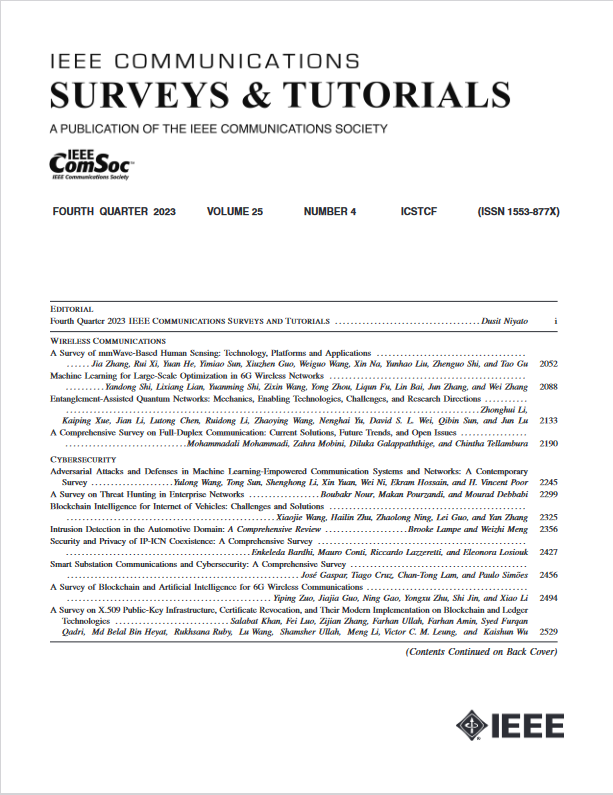用于验证、保密和恶意节点检测的物理层安全:物联网网络安全的范式转变
IF 34.4
1区 计算机科学
Q1 COMPUTER SCIENCE, INFORMATION SYSTEMS
引用次数: 0
摘要
随着第六代移动网络(6G)的即将到来,全球商业物联网(IoT)的普及率预计将达到相当高的水平。在过去的几年里,全球无线标准化机构一直积极致力于物联网网络的部署和性能优化,并将其与当前和未来的蜂窝网络相融合。然而,无线传输的开放性和联网设备的迅猛增长将引发前所未有的安全漏洞和漏洞。除了 6G 和物联网的关键目标外,在超大规模连接的异构网络中采用适当的轻量级安全机制也至关重要。最近,人们做出了巨大努力,为在当代和未来网络中集成物理层安全(PLS)铺平道路。部署物理层安全的主要动机在于它的低复杂性和提供信息论安全传输的能力,这减轻了实施复杂加密方案所带来的复杂性负担。本调查概述了 PLS 技术的最新进展,尤其关注其在物联网(IoT)中的应用。我们回顾了近期旨在确保信息保密性、节点/信息身份验证和恶意节点检测的 PLS 技术,并讨论了其相应的应用场景和基本利弊。此外,我们还探讨了在物理层结合尖端技术的最新研究成果,如非正交多址、可重构智能表面、联合通信和传感以及光无线/太赫兹通信,以提高物理层的保密性和认证。最后,根据每个 PLS 类别的量化利弊,讨论了有前景的扩展和未来方向,为该主题内的及时研究方向和 PLS 当前/未来面临的挑战开辟了途径。本文章由计算机程序翻译,如有差异,请以英文原文为准。
Physical Layer Security for Authentication, Confidentiality, and Malicious Node Detection: A Paradigm Shift in Securing IoT Networks
The pervasiveness of commercial Internet of Things (IoT) around the globe is expected to reach significant levels with the upcoming sixth generation of mobile networks (6G). Throughout the past years, wireless standardization units worldwide have been prominently active in the deployment and performance optimization of such IoT networks and fusing them with current and futuristic cellular networks. Nonetheless, the openness of wireless transmissions and the forecasted overwhelm in connected devices will provoke unprecedented security leakages and vulnerabilities. In addition to the key targets of the 6G and IoT, it has been of paramount importance to cater to decent and lightweight security mechanisms in ultra-massively connected heterogeneous networks. Recently, significant efforts have been made to pave the way for the integration of physical layer security (PLS) in contemporary and futuristic networks. The primary motivation behind its deployment resides in its low complexity and ability to provide information-theoretic secure transmissions, which alleviates the complexity burden caused by implementing complex cryptographic schemes. This survey overviews the recent advancement in PLS techniques with a particular interest in its application to the Internet of Things (IoT). We review essentially recent PLS techniques aiming at ensuring message confidentiality along with node/message authentication and malicious nodes’ detection, where their corresponding application scenarios and underlying pros and cons are discussed. On top of that, we explore recent findings in the incorporation of cutting-edge technologies at the physical layer, such as non-orthogonal multiple-access, reconfigurable intelligent surfaces, joint communication and sensing, and optical wireless/Terahertz communications in boosting confidentiality and authentication at the physical layer. Lastly, promising extensions and future directions are discussed based on the quantified pros and cons of each PLS category, opening up ways for timely research directions within the topic and current/future challenges faced by PLS.
求助全文
通过发布文献求助,成功后即可免费获取论文全文。
去求助
来源期刊

IEEE Communications Surveys and Tutorials
COMPUTER SCIENCE, INFORMATION SYSTEMS-TELECOMMUNICATIONS
CiteScore
80.20
自引率
2.50%
发文量
84
审稿时长
6 months
期刊介绍:
IEEE Communications Surveys & Tutorials is an online journal published by the IEEE Communications Society for tutorials and surveys covering all aspects of the communications field. Telecommunications technology is progressing at a rapid pace, and the IEEE Communications Society is committed to providing researchers and other professionals the information and tools to stay abreast. IEEE Communications Surveys and Tutorials focuses on integrating and adding understanding to the existing literature on communications, putting results in context. Whether searching for in-depth information about a familiar area or an introduction into a new area, IEEE Communications Surveys & Tutorials aims to be the premier source of peer-reviewed, comprehensive tutorials and surveys, and pointers to further sources. IEEE Communications Surveys & Tutorials publishes only articles exclusively written for IEEE Communications Surveys & Tutorials and go through a rigorous review process before their publication in the quarterly issues.
A tutorial article in the IEEE Communications Surveys & Tutorials should be designed to help the reader to become familiar with and learn something specific about a chosen topic. In contrast, the term survey, as applied here, is defined to mean a survey of the literature. A survey article in IEEE Communications Surveys & Tutorials should provide a comprehensive review of developments in a selected area, covering its development from its inception to its current state and beyond, and illustrating its development through liberal citations from the literature. Both tutorials and surveys should be tutorial in nature and should be written in a style comprehensible to readers outside the specialty of the article.
 求助内容:
求助内容: 应助结果提醒方式:
应助结果提醒方式:


